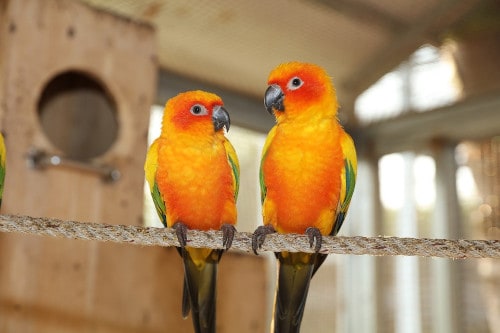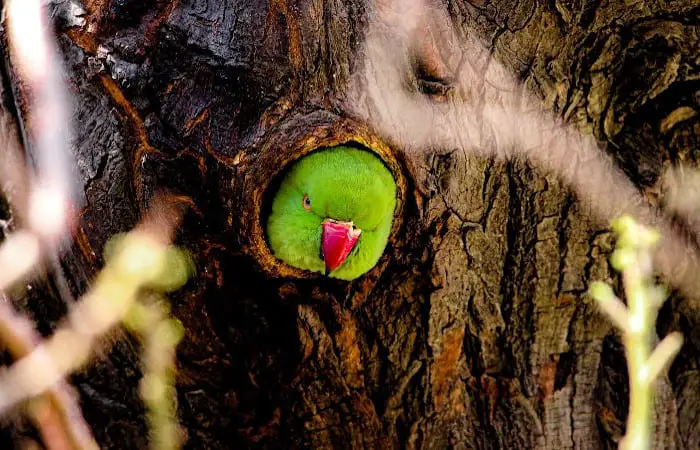Do parrots build nests? The answer to that question is a little complicated.
Some species of parrot do, while others don’t.
In this blog post, we will take a closer look at the different types of nests that parrots build and why they do it.
We will also discuss the benefits of building nests and how you can encourage your pet parrot to start nesting.
Do all parrots build nests?
Most species of parrots do not build nests, though there are a few exceptions.
Parrots are secondary nest builders, using tree cavities, caverns, cliff sides, riverbanks, and the ground as nesting sites.
The nest is typically made from twigs, leaves, and other plant material. Some species of parrot will line the nest with feathers, hair, or even bits of cloth.
The female usually does the majority of the work, though the male will sometimes help with construction.
Once the nest is complete, the female will lay her eggs and incubate them for about 2-4 weeks.
After they hatch, the chicks will remain in the nest for another 5-6 weeks before they fledge and strike out on their own.
Where do parrots make their nests?

There are some common nesting sites where wild parrots make their nests: tree cavities, cliff caves, bank cavities, and ground sites.
Tree cavities
Tree cavities are the most common type of nest site for parrots.
Often, these cavity-nesting birds will compete with others for nest locations, such as woodpeckers.
The woodpecker’s holes are an important habitat resource not only for parrots but also for squirrels, owls, and a variety of other animals.
Some tree species have enlarged trunk cavities that form naturally while others result from wounds caused by fire, storm damage, or decay.
Cliff cavities
Cliff cavities can be found in rocky cliffs near rivers or cascades.
These cavities are typically large and may have multiple entrances.
They offer protection from predators and the weather but can be dangerous for nesting birds if the water level rises suddenly during a flood.
River bank cavities
River bank cavities are burrows that parrots excavate in riverbanks.
These nests are usually close to the ground and provide good camouflage for the birds.
However, they can be vulnerable to predators and flooding.
Ground nests
Ground sites are less common but are used by some species of parrot.
These nests are usually a simple scrape in the ground lined with leaves or other vegetation.
They offer little protection from predators or the weather but can be easier to build than other types of nests.
You may also like: Do Cockatiels Lay Eggs Without Mating? 11 Things To Know
Why do parrots need nests?
There are a few reasons why parrots need nests.
The first is to provide shelter for themselves and their young. Nests offer protection from the weather and predators.
The second reason is to help the parents incubate their eggs and care for their chicks. The nest provides a safe place for the eggs and chicks to develop.
The third reason is to help the parent birds keep track of their young. By remaining in the nest, the chicks are easier for the parents to find and protect.
Building a nest is also a way for parrots to bond with their mates. The process of building a nest together helps the pair form a strong bond that will last for years.
Finally, nesting is an instinctive behavior for parrots. It is something that they are hardwired to do and it gives them a sense of satisfaction.
You may also like: Do Parakeets Mate for Life? What To Know About Breeding Parakeets?
Which parrots build nests?
While most parrots find cavities as their nests in the wild, some parrot species do build their nests.
Quaker parrots
The Quaker parrot, also known as the monk parakeet, is one of the most common nesting parrots in North America.
These small green parrots typically build their nests in tree cavities or in cliffs.
Lovebirds
Lovebirds are another type of nesting parrot.
These birds get their name from their strong pair bonds and their affectionate nature.
Lovebirds typically build their nests in trees or bushes.
Ground parrots
Ground parrots are the third type of parrot that builds nests.
As their name suggests, these birds make their homes on the ground.
Ground parrots typically build their nests in dense vegetation such as shrubs to protect themselves from predators.
All three of these types of parrots are interesting birds that build unique nests.
Do parrots sleep in nests?
Most parrots do not sleep in nests, but some may roost in them during the day.
Generally, parrots like to sleep in elevated, safe places where they can see their surroundings.
This could be on a perch in their cage or aviary, or in a tree if they are wild.
Some parrots may also sleep in communal roosts with other parrots of their species.
Parrots sleep in nests at night during nesting seasons to give their eggs or young warmth and protection from predators.
While they don’t necessarily need a nest to sleep in, many parrots will still build one for the purpose of incubating eggs and raising their young.
Nests can provide a sense of security for birds and help them feel at home, so even though your parrot may not actually sleep in its nest, it’s still a good idea to provide one.
You may also like: Can Budgies Breed Without A Nest Box? Everything About Budgie Breeding
Why do pet parrots need a nesting box?

A nesting box is an essential piece of equipment for any pet parrot.
Parrots are natural nest builders, and they will instinctively search for a safe, secluded place to lay their eggs.
If they don’t have a nesting box, they may try to build a nest in your hair, in a pot of plants, or even in your clothes.
In addition to being messy, this can also be dangerous for your parrot.
Nesting boxes provide a safe and comfortable place for parrots to lay their eggs, and they help to keep the birds calm and relaxed.
In addition, nesting boxes can also be used as a perch or a play area for your parrot.
By providing a nesting box, you can give your pet the perfect place to nest and rest.
Why don’t you let pet parrots build nests at home?
Many people believe that pet parrots should be allowed to build nests at home, but there are a few good reasons why this is not always the best idea.
First of all, parrots are very messy birds, and their nests can quickly become cluttered with bits of food and other debris.
Additionally, as parrots feather their nests, they often create a lot of dust and noise, which can be disruptive for both the bird and its owners.
Finally, if not properly maintained, parrots’ nests can become infested with parasites, which can pose a serious health risk for both the bird and the people in its home.
For these reasons, it is generally advisable to avoid letting pet parrots build nests inside the house.
Conclusion
Do parrots build nests?
Parrots in the wild typically build their nests in tree cavities or in cliffs, while pet parrots usually require a nesting box.
In the wild, most parrots nest in holes or cavities while a few parrot species such as Quaker parrots, lovebirds, and ground parrots build their own nests.
In captivity, nesting boxes provide a safe and comfortable place for parrots to lay their eggs, and they help to keep the birds calm and relaxed.
By providing a nesting box, you can provide your pet with the ideal location to nest and relax.
